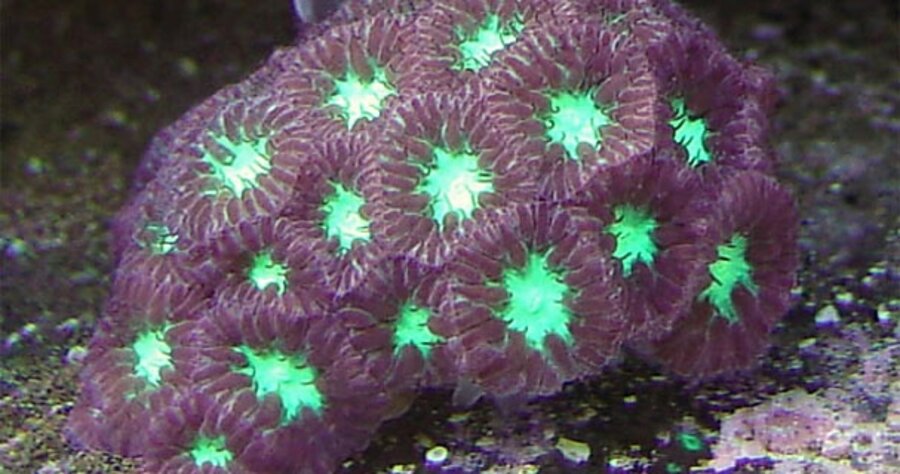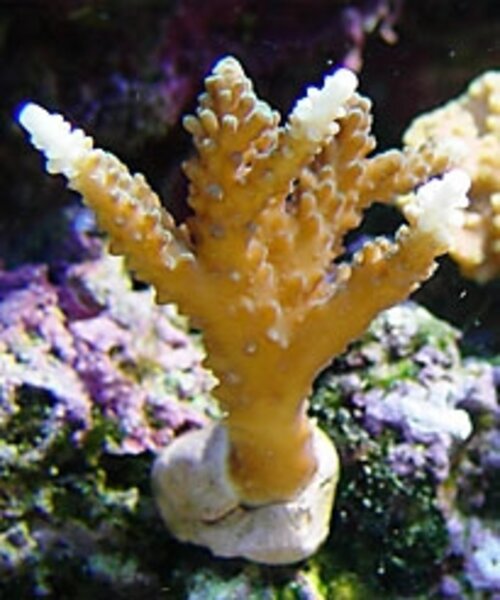A coral farmer’s harvest of ‘living stones’
Loading...
| Freeville, N.Y.
Steve Lowes is a coral farmer. He doesn’t live on an island in the Caribbean or even within spitting distance of an ocean. Rather, his farming takes place in 100-gallon saltwater tanks in the basement of his neat and tidy house the color of a warm Sargasso Sea in upstate New York. Mr. Lowes, a native of northeastern England, came to New York in the mid-1990s to work for a high-tech pharmaceutical company.
He’s a PhD biochemist with a penchant for lovely corals.
Lowes, who grew up landlocked, developed his fascination with corals by watching Jacques Cousteau documentaries as a kid. In college, he learned to scuba dive and began collecting corals from the temperate zones around the world. Since 2002, he’s farmed coral in his basement. There, he propagates, nurtures, and then sells his captive-raised livestock – about 50 species of coral – to aquarium supply firms and pet stores throughout the Northeast. His specimens sell for between $10 and $1,000, depending on their rarity. Lowes is one of about a dozen commercial coral farmers in the United States. Captive-raising coral helps limit the amount of coral poached from wild reefs.
Lowes stands before a 125-gallon saltwater tank – his display aquarium – that holds a glorious array of coral, anemones, and colorful fish. One large anemone looks like a Victorian love seat with purple edging and lime-green interior. The intense colors of the corals are heightened by lighting and the nutrient levels, which stress the corals a bit and bring out the color.
“These are all Indo-Pacific corals – it’s illegal to take corals from American waters,” says Lowes. Corals come in an astonishing variety of sizes and shapes. Lowes does not collect his own coral – that requires a license – but all the coral farmers he knows trade with one another for different species to keep stock varied.
All the corals Lowes grows have a symbiotic relationship with a plant – a one-celled algae known as zooxanthellae – that lives inside their tissue. That’s how corals get their color. When light hits coral, the algae converts it into sugar via photosynthesis. The coral, in turn, eats this sugar. Competition among corals for access to light is played out in the tank.
Lowes points to the top of the display tank. “Look at how that green coral is right up against the pink coral,” said Lowes. “It will eventually grow over the pink one in an effort to grab all the light.”
Corals also eat other creatures such as zooplankton, shrimp, and fish – all of which are in Lowes’s tank. In fact, some creatures in the tank wouldn’t normally occur in nature. An unusual-looking black-and-white clownfish nuzzles the edge of the purple-and-green anemone. “I’m keeping my eye on that,” says Lowes. “That’s a captive-raised clownfish that has somehow been able to build up enough protection against the stings of that anemone that it’s able to hang out inside it now. In the wild, clownfish would never be in that anemone.”
All of Lowes’s corals are clones. He walks to a workbench where a piece, or “frag,” of a stony coral sits in a small plastic container. He places it on the work surface and cuts off a small 1-1/2-inch-long branch. Then a bit of superglue is applied to the cut on the frag, which is then affixed to a plastic sheetrock screw. The new clone is then placed in a rack made from a plastic light diffuser of the type used on a fluorescent ceiling light. Ideally the rack would be filled with frags in a saltwater holding tank where over several months they’d double in size. At that point they’re ready for market.
“His corals are excellent,” says Karen Klos, manager of The Reef Shoppe in Rochester, N.Y. “We’ve bought corals from Steve in the past – he’s probably the best in the business because he’s been at it a long time and really knows what he’s doing.”
Behind the display tank, sit the three 100-gallon saltwater tanks. Today they’re empty of everything but live rock – the porous rock on which Lowes plants his coral.
Lowes is a bit chagrined. “The coral farming business is a good indicator of the economy,” he says. He and a friend who was farming clownfish noticed a downtick in business about a year ago, so rather than crank things up for the growing season, which is winter, Lowes decided not to grow any corals this year. It seems that when times get tough, people don’t want to invest in expensive saltwater aquaria. A big system like Lowes’s, with its complex filtration (mechanical and biological) and circulation system can cost up to $30,000.
This isn’t the end of the coral-farming business for Lowes, however, just a hiatus. He’ll observe and tinker and conduct some experiments with his holding tanks. He’s fascinated by the potential of his captive glass-box environment. It’s difficult to study reefs in the wild and some of the advances in this hobby have led to a better understanding of many species of coral.
“The hobby trade really figured out how to keep corals alive in captivity,” says Joseph Yaiullo, cofounder of Atlantis Marine World on Long Island, N.Y., home of the Western Hemisphere’s largest all-living coral reef display. “Scientists studied corals out in the wild but weren’t good at keeping them alive out of the wild.”
For Lowes, it’s an opportunity to try to answer all sorts of questions: Why do corals react the way they do to changes in light, temperature, and water chemistry? Are there beneficial uses for the toxins corals release in self-defense? And Lowes will also think about what climate change is doing to coral reefs, which are some of the richest zones of biodiversity in the world.
“We’re seeing extinction of corals on reefs on an alarming scale, and it’s up to biologists to catalog these species before we lose them. But we’re also seeing that some – not all – but some corals are able to rapidly evolve along with climate change,” says Lowes. “We don’t really understand why.” Perhaps the algae are adapting, he says.
The jury’s still out on whether farmed corals help reduce the poaching of wild corals.
“While I’m certainly hopeful that farming coral can somehow reduce the damage to fragile natural reefs, the all-too-frequent economic realities of profit trumping conservation give me pause,” says Rick MacPherson, conservation programs director of The Coral Reef Alliance (CORAL). “We all want to hear that farmed coral species are somehow more sustainable than the wild alternatives. Unfortunately, it’s not that simple. For example, we learned that farming salmon can be as environmentally damaging – or worse – than wild-caught salmon. It’s not a simple cause-and-effect relationship wherein farmed coral automatically removes the pressure of wild harvesting.”






